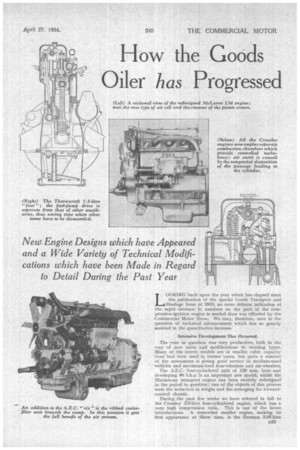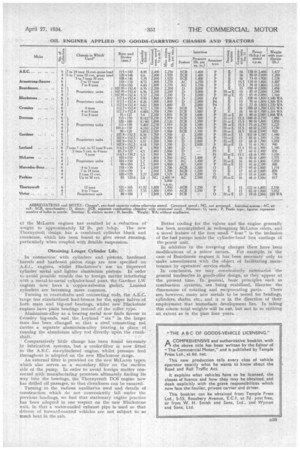How the Goods
Page 89

Page 90

Page 91

If you've noticed an error in this article please click here to report it so we can fix it.
Oiler has Progressed LOOKING back .upon the year which has elapsed since the publication of the special Goods Transport and Haulage Issue of 1933, no more definite indication of the rapid increase in numbers on the part of the compression-ignition engine is needed than was afforded by the Commercial Motor Show. We may, therefore, turn to the question of technical advancement which has so greatly assisted in the quantitative increase.
. Intensive Development Has Occurred.
The year. in question was very productive, both in the way of new units :and modifications to existing types. -Many of the recent models are of smaller cubic capacity than had been used in former years, hut quite a number of the newcomers is giving good service in medium-sized vehicles and maximum-load four-wheelers and six-wheelers.
The A.E.C. four-cylindered unit of 120 mm. bore and developing 90 b.h.p. is an important new model, whilst the Blackstone transport engine has been entirely redesigned in the period in question; two of the objects of this process were the reduction in weight and the arranging for forwardcontrol chassis.
During the past few weeks we have referred in full to the Crossley 3.6-litre four-cyiindered engine, which has a very high compression ratio. This is one of the latest introductions. A somewhat smaller engine, making its first appearance at Show time, is the -Dorman 3.05-litre
four-cylindered unit, which embodies the Dorman-Ricardo combustion '.system in commen with others of the same make. The smallest of the Gardner range appeared also at Olympia, being a three-cylindered unit of 4.18 litres, following the general characteristics of the LW series.
Two new Leylands have been introduced, one a fourcylinderecl unit of 51 litres, and the other designed for a higher crankshaft speed, intended for vehicles in the Cub range.
Another make which has been redesigned and is now specially suited to forward-control chassis is the McLaren. In addition, the range has been extended by adding what is certainly one of the smallest four-cylindered engines. It is of 2.5-litres capacity and has a relatively low piston speed, despite its high rate of rotation of the crankshaft.
Also characterized by its ability to turn over quickly, is the Perkins engine, which is actually made in three sizes, but production is chiefly centred upon the largest. This engine has been commercially established during the past year and hat done, much to introduCe oil-engine economy into the sphere of smaller vehicles.
. The latest Thornycroft engine of 7.88 litres differs in certain respects from 'others of the Basingstoke family, hut is primarily intended for passenger service. A new-comer during the period under review is the Victor 1-litre horizontally opposed twin, which is employed in 13ristol tracklaying tractors and for other industrial purposes.
This is the smallest transport unit available at the present time,
Being of such vital importance, the question of combustion takes pride of place in consideration of individual items of design. The British-built Arnistroug-Saurer differs in many ways from the Swiss engine as originally introduced into this country-. In the past year the disposition of the air cell and atomizer has changed, and fuel is now injected farther into the cell.
In the Blackstone range, the practice has been established D24 of casting singly the combustion chambers. Improved power and a clearer exhaust are claimed to result, whilst spring injection has given place to the C.C.C. pump, which has found it place on many other Blackstone engines. Fuel consumption has been reduced. Another combustion improvement occurs in the Crossley, in which anew atomizer has resulted in quieter running and a clearer exhaust. Various modifications in the Gardner design have affected a decrease in the fuelconsumption rate to about .365 lb. per b.h.p.-hour, which is a striking figure for a small engine.
Easier starting, more silent running and reduced maximum pressures are being achieved in the McLa.ren. design by the use of an entirely different type ofair cell. This appeared at Show time and was widely discussed in particular connection with the new small " four."
• On one type of Thornycroft engine, automatic advance of the injection point has been arranged by interconnecting the pump-timing control to the accelerator pedal.
An allied -question to combustion is air intake._ On the latest Dorman units a new manifold arrangement has been made which carries the air filter over to the near side. On the McLaren engines and on one type of Thornycroft the intake air is drawn through special passages in the cylinderhead covers, largely with the Object of reducing noise and facilitating air cleaning; this also decreasesengine bulk.
As regards the larger castings, it new -feature is the slotting of cylinder heads of A.E.C. make, in order to allow for head expansion. In redesigning, the Blackstone units have been "cleaned up" and the smooth exterior is e.Tecially noticeable around the cylinder head. Lighter crankcases and valve covers have been standardized in Crossley engines. Gardner products now incorporate a vacuum exhauster of the reciprocating type 8, ut o ma heal 1 y lubricated.
More generous use of an aluminium alloy, in the case cf the McLaren engines has resulted in a reduction of weight to approximately 12 lb. per b.h.p. The new Thornycroft design has a combined cylinder block and crankcase, which has been found to give sweet running, particularly when coupled with flexible suspension.
• Obtaining Longer Cylinder Life.
In connection with cylinders and pistons, hardened barrels and hardened piston rings are now specified on A.E.G. engines, whilst Blackstone's use an irnproved cylinder metal and lighter aluminium pistons. In order to avoid possible trouble due to foreign matter interfering with a metal-to-metal cylinder-head joint, the Gardner LW engines now have a copper-nsbestos gasket. . Littered cylinders are becoming more common.
Turning to crankshafts and connecting rods, the A.E.C. range has standardized lead-bronze for the, upper halves of both main and big-end bearings, Whilst new Blackstone engines have plain bearings. instead of the roller type: '
Aluminium-alloy as a bearing metal now finds favour in Crossley big-ends, and the Leyland " six " in the larger sizes has been changel so that a steel 'connecting rod carries a separate aluminium-alloy bearing, in place, of running the aluminium alloy rod directly upon the crankshaft.
Comparatively little change has been found necessary in lubrication systems, but a. cooler-filter is now fitted to the A.E.C. six-cylindered engine, whilst pressure feed throughout is adopted on the new Blackstone range.
An external filter is provided on the new McLaren types, which also serves as a secondary filter on the suction side of the pump. In order to avoid foreign matter connected with manufacturing processes ultimately finding its way into the bearings, the Thornycroft DC6 engine now has drilled oil passages, so that cleanliness can be ensured."
Turning to the various auxiliaries used and details of construction which do not conveniently fall under the previous headings, we find that stationary engine practice has been adopted in one respect on the new Blackstone Imit, in that a water-cooled exhaust pipe is used so that drivers of forward-control vehicles are not subject to so ranch heat in the cab. Better cooling for the valves and the engine generally has been accomplished „in redesigning McLaren oilers, and a novel feature of the new small " four" is the inclusion of the fuel pumps inside the cylinder-head bojc castings of the power unit.
In addition to the foregoing changes there have been modifications of a minor nature. For example, in the case of Beardmore engines it has been necessary only to makeamendments with the object of facilitating maintenance by operators' service staffs.
In conclusion, we may conveniently summarize the general tendencies in goods-oiler design, as they appear at the present time. In general, basic principles such as combustion systems, are being stabilized, likewise the dimensions of rotating and reciprocating parts. There are, however, many new metals to be tested for bearings, cylinders, shafts, etc., and it is in the direction of their employment that immediate development lies. In taking -this cdurse total weights will be cut, but not to so striking art extent as in the past four years.




















































































































































































